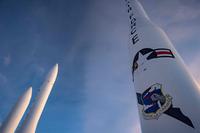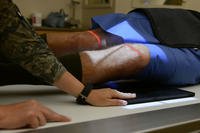After years in development, the U.S. military's latest attempt at an airborne laser weapon to protect troops on the ground from incoming ballistic missiles appears to be headed for the scrapyard.
Initiated in 2016, the Self-Protect High-Energy Laser Demonstrator, or SHiELD, was envisioned as a laser weapon mounted on fighter jets such as the F-22 Raptor and F-35 Lightning II that would neutralize incoming air-to-air and surface-to-air missiles, as well as ballistic missiles potentially targeting U.S. forces abroad, according to a 2023 Congressional Research Service report.
The Air Force had planned on the SHiELD system taking flight for airborne testing aboard an F-15 Eagle some time in fiscal 2024. The service had already reported a successful ground-based shootdown of test missiles and taken receipt of the laser weapon system and pod subsystem in recent years. But any plans to complete the weapon and put it into operation now appear to have been abandoned, according to service officials.
"The SHiELD program has concluded, and there are no plans for further testing and evaluation," Dr. Ted Ortiz, SHiELD program manager at the Air Force Research Laboratory's Directed Energy Directorate, told Military.com in an email. "The Air Force has not installed a laser pod on a fighter jet test bed."
SHiELD is the second airborne laser weapon effort that the Air Force has scrapped in recent months. In March, Air Force Special Operations Command revealed that it had abandoned plans to mount an Airborne High Energy Laser system, or AHEL, on a AC-130J Ghostrider gunship, citing "technical challenges" even with "significant end-to-end, high-power operation" during ground tests.
Despite that, Air Force officials remain bullish on the potential for airborne laser weapons to reshape the battlefield.
"Through SHiELD and related efforts, [the Air Force Research Laboratory] has made significant advances in the readiness of airborne [high-energy laser] technology, and we continue to mature airborne HEL weapons technology for the operational needs of today and tomorrow," Ortiz said.
News of the SHiELD program's conclusion comes as the Defense Department seeks to bolster air defenses for U.S. troops deployed overseas as the threat of adversary missile attacks has grown.
Iran conducted the largest ballistic missile attack on American forces abroad ever in January 2020 in response to the U.S. assassination of top Islamic Revolutionary Guard Corps Gen. Qasem Soleimani, resulting in traumatic brain injuries among at least 110 service members.
In recent months, Iran-backed militias have been taking potshots at U.S. forces in Iraq and Syria and at Navy warships in the Red Sea in response to Israel's military campaign in Gaza, resulting in even more TBI diagnoses among U.S. troops.
With drone and missile attacks on the rise, the Pentagon has increasingly eyed directed-energy weapons such as lasers and high-powered microwaves that, with a low cost-per-shot and a virtually unlimited magazine, could eventually provide efficient low-cost alternatives to existing -- and costly -- air defense systems such as the $125,000-a-pop Coyote interceptor or the $2 million-a-shot, ship-launched Standard Missile-2.
To that end, the Army recently deployed a pair of ground-based laser weapons overseas to help counter incoming drones and is investing heavily in the development of more powerful systems designed to counter even fast-moving cruise missiles. Meanwhile, the Pentagon is spending around $1 billion per year on at least 31 directed-energy programs, according to C4ISRNet.
Deploying airborne laser weapons for missile defense has been a goal since the Air Force's Boeing 747-based YAL-1 Airborne Laser Test Bed knocked ballistic missiles out of the sky during testing in the 2000s.
Even before the uptick in missile attacks on U.S. troops, the Pentagon's 2019 Missile Defense Review suggested that "developing scalable, efficient, and compact high-energy laser technology holds the potential to provide a future cost-effective capability to destroy boosting missiles in the early part of the trajectory," and that mounting laser weapons aboard unmanned aerial vehicles could prove an effective countermeasure to ballistic missiles such as those in Russia and China's arsenals.
But developing effective and reliable airborne laser weapons has proven challenging compared to their ground vehicle- and warship-based counterparts, as former Pentagon research and engineering chief Mike Griffin detailed in 2020, according to Breaking Defense.
The first problem is power generation. Lasers require a significant amount of power to produce their destructive beam, and generating that amount of power from a relatively small tactical aircraft is a major engineering challenge.
The second problem is the beam itself. Even if you generate enough power, the atmospheric turbulence involved with operating a fighter jet in combat makes it nearly impossible to maintain a coherent laser beam for long enough to successfully engage a ballistic missile in flight.
"I think it can be done as an experiment, but as a weapon system to equip an airplane with the kinds of lasers we think necessary -- in terms of their power level, and all their support requirements, getting the airplane to altitudes where atmospheric turbulence can be mitigated appropriately -- that combination of things doesn't go on one platform," as Griffin put it in a May 2020 conference call with reporters, according to Breaking Defense.
One month after Griffin's comments, then-Pentagon acquisition chief Will Roper said that the Air Force was rethinking the potential applications of the laser weapon technology developed through the SHiELD program beyond integrating the system into a tactical fighter jet, Defense News reported.
"What I've told that team is, 'Let's have a dialogue,'" Roper said in June 2020, per Defense News. "Let's understand the different power levels and what they should correspond to, and let's not make the highest power level that we can dream up and the mission that's the sexiest be the thing that drives us."
With the SHiELD program concluded and the AHEL defunct, the Defense Department's dream of airborne laser weapons seems as distant as ever. But as the Pentagon continues to invest in directed-energy programs to deal with the rising tide of adversary drone and missile attacks, chances are high that the Air Force's efforts in that arena are far from finished.
"After many years of development, HEL weapons are now a battlefield reality," Ortiz said. "The game-changing features of HEL weapons -- deep magazine, scalable effects, and speed-of-light engagement -- combined with the potential logistics benefits of a weapon that effectively uses jet fuel for ammunition, make air platform integration a natural next step."
Related: The Air Force's Dream of Mounting a Laser Weapon on an AC-130J Ghostrider Gunship Is Dead














